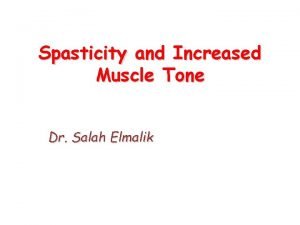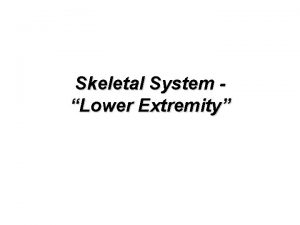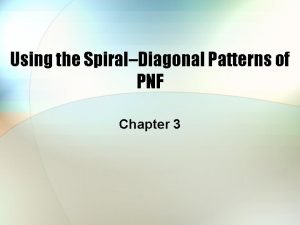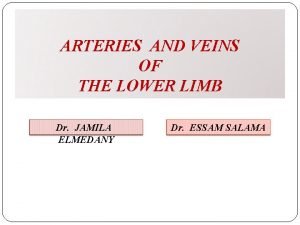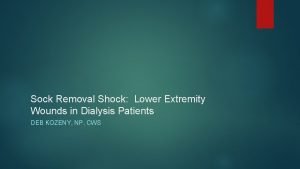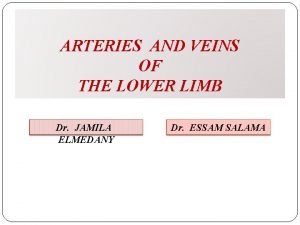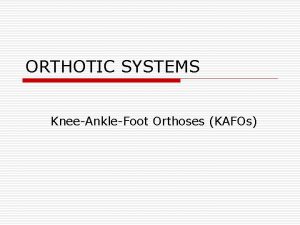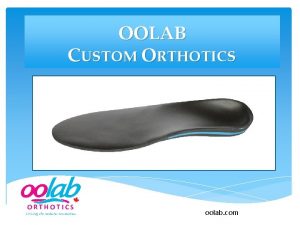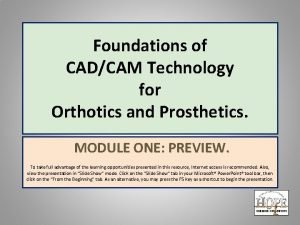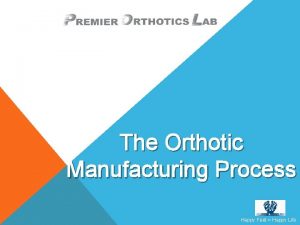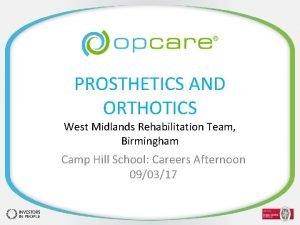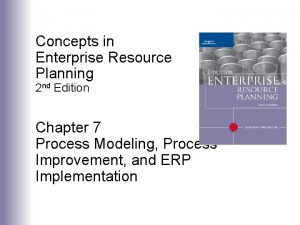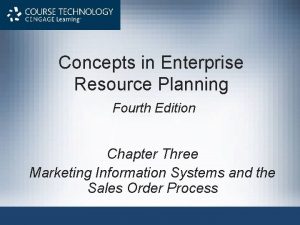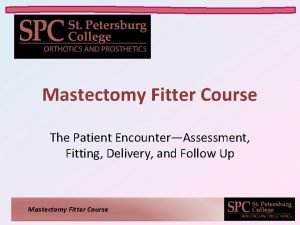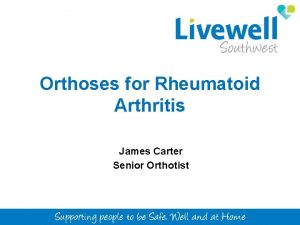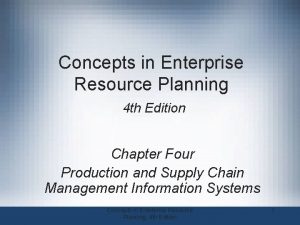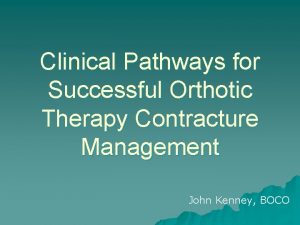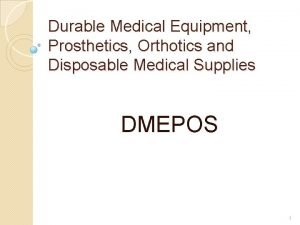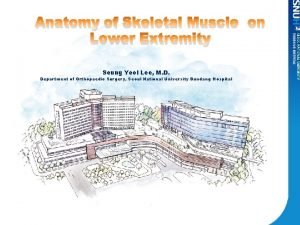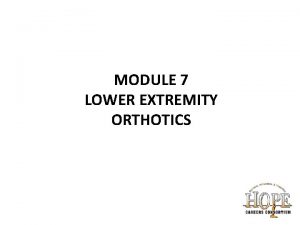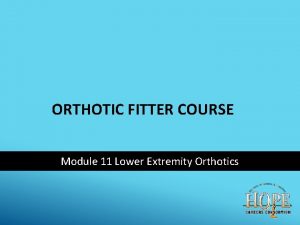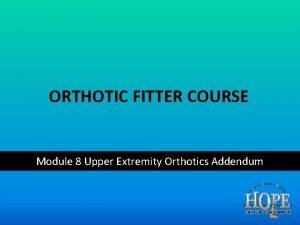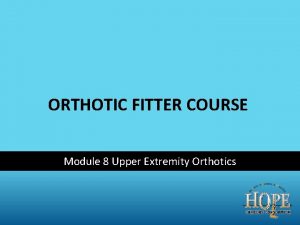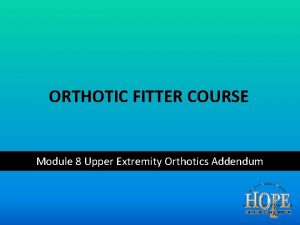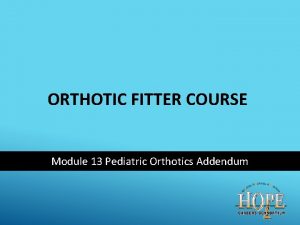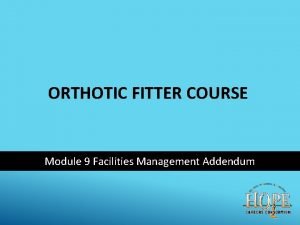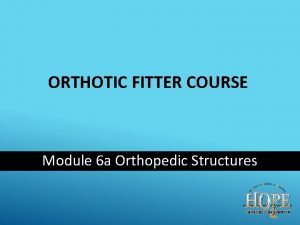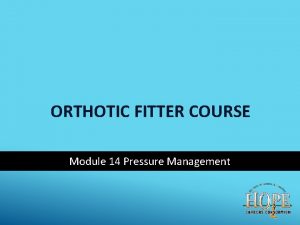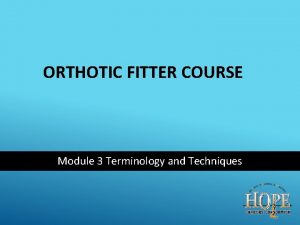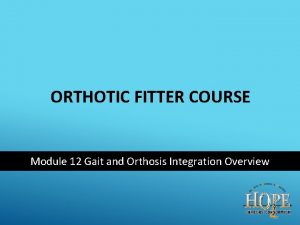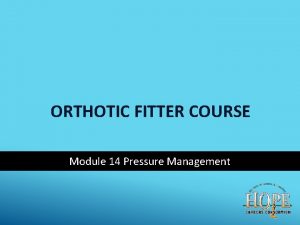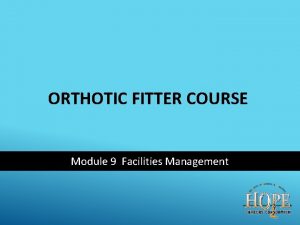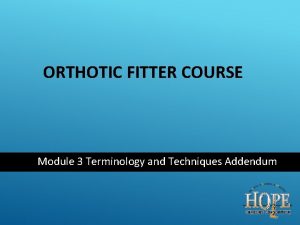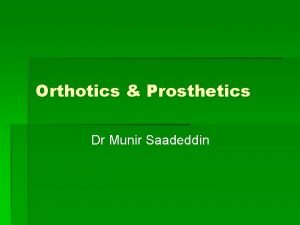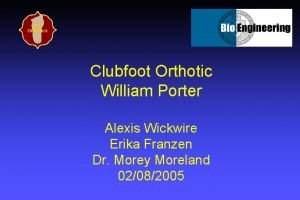ORTHOTIC FITTER COURSE Module 11 Lower Extremity Orthotics























- Slides: 23

ORTHOTIC FITTER COURSE Module 11 Lower Extremity Orthotics Addendum

LEARNING OBJECTIVES • Learning Objectives • Pathologies • Product Preview • Knee Brace Policy

LOWER EXTREMITY ORTHOTICS—ADDENDUM • Conditions • Osteoarthritis (Knee) • • • Compartment syndrome Ligament Insufficiency • Anterior (ACL) • Medial (MCL) • Lateral (LCL) Meniscus Tears

CONDITIONS • Conditions • Patellar Subluxation • Chondromalacia

ADDITIONAL CONDITIONS • Additional Conditions • Diabetes Mellitus • Type I – usually diagnosed in children or young adults. The body does not produce insulin. • Type II – Most common form, in which the body does not produce enough insulin, or ignores the insulin. • Insulin is required to break down sugar. • If sugar can’t be broken down and absorbed, it accumulates in blood.

DIABETES MELLITUS • Additional Conditions • Diabetes Mellitus • • Sugar accumulation in blood causes: • Cells starved for energy. • Over time damage to eyes, kidneys, nerves and/or heart. Often times peripheral neuropathy is present in diabetic patients. • Neuropathy is damage to nerves which causes pain and/or loss of sensation.

LEG LENGTH DISCREPANCY (LLD) • Additional Conditions • Leg Length Discrepancy (LLD) • This condition means there is a measurable difference between lengths of the legs. • It can be congenital or acquired. • • Congenital – birth defect. • Acquired – happened after birth; i. e. from injury, surgery or other disease process. Patients are not always aware that they have LLD.

LLD • Additional Conditions • Leg Length Discrepancy (LLD) • It is not necessary to completely correct or even correct at all. • • Measurements are done by X-ray or functionally by standing on blocks. ½ inch or less can be accommodated with a tapered lift placed inside the shoe (over ½ inch should be added to the sole of the shoe).

INFLAMMATION • Additional Conditions • • Bursitis • Bursae exist at sites of bone to tendon friction. • Repeated excessive friction causes inflammation. Tendonitis • • Inflammation of a tendon. Orthotic treatment limits the motion causing the inflammation.

POSTERIOR TIBIAL TENDON DYSFUNCTION (PTTD) • Additional Conditions • Posterior Tibial Tendon Dysfunction (PTTD) • Tibialis Posterior (TP) is the primary stabilizer of the medial longitudinal arch. • Dysfunction of the TP tendon allows the hindfoot to evert and the midfoot to be flexible during stance.

PTTD • Additional Conditions • Posterior Tibial Tendon Dysfunction (PTTD) • • Treatment varies depending on the stage of PTTD. • Stage 1 to 2 – immobilize for 3 to 6 weeks in CAM Walker, then an FO for support afterwards. • Stage 3 to 4 – orthotic device above the ankle is indicated to help prevent/correct hindfoot eversion. Gauntlet style AFOs, Articulated AFOs, Solid ankle AFOs and Metal upright AFOs are all options. *Custom fabricated orthoses are outside the scope of practice of the Orthotic Fitter.

ACHILLES TENDON RUPTURE • Additional Conditions • Achilles Tendon Rupture • Usually caused by strenuous athletic activities. • Two treatment options: • Operative – Surgeon repairs Achilles tendon rupture and managed post-operatively with CAM walker. • Non-Operative – Patient is immobilized in a plantar-flexed position and gradually dorsi-flexed as the tendon heals.

MIDFOOT/METATARSAL FRACTURES • Additional Conditions • Midfoot/Metatarsal Fractures • Can be caused by an injury or pathological. • If the injury in the foot is isolated below the ankle, a short CAM walker or Post-Op shoe is indicated to treat. *Fracture treatment is outside the scope of practice of the Orthotic Fitter.

KNEE IMMOBILIZER • Additional Product Previews • Knee Immobilizer. • Typically used for acute care treatment. • Typically sized (by length) or universal. • 3 -pan or basic.

KNEE RANGE OF MOTION • Additional Product Previews • Knee Range of Motion (ROM) • Also called Post-op knee brace. • Adjustable dial(s) at the knee joint that allow clinician to set ROM.

PRESSURE RELIEF AFO • Additional Product Previews • Pressure Relief (heel) AFO • Used to keep pressure off the heel when laying supine.

ADDITIONAL PRODUCT PREVIEWS • Additional Product Previews • • Post-Op Shoe • Rigid sole that does not bend. • Used to immobilize midfoot and toe motion. Offload

MEDICARE KNEE BRACE POLICY • Medicare Knee Brace Policy • Implemented 2008 and has been updated each year. • Knee braces fit to Medicare patients are required: • PDAC approval coding. • Used for an approved diagnosis. • Limited add-on codes that must be medically justified.

EXAMPLE • Medicare Knee Brace Policy • Example: • L 1830, L 1832, L 1843 and L 1845 are covered if patient has one or more of the following diagnoses:

DIAGNOSIS AND ICD-9: CHART. Diagnosis. Rheumatoid arthritis Osteoarthritis Meniscal cartilage derangement Chondromalacia of patella Knee ligamentous disruption Rupture of tendon, non-traumatic—quadric eps tendon Rupture of tendon, non-traumatic, site—patellar tendon Pathologic fracture of femur Pathologic fracture of tibia or fibula Aseptic necrosis of tibia or fibula ICD-9. 714. 0 to 714. 4. 715. 16, 715. 26, 715. 36, 715. 96. 717. 0 to 717. 5. 717. 7. 717. 81 to 717. 9. 727. 65. 727. 66. 733. 15. 733. 16. 733. 49.

MEDICARE LOCAL COVERAGE • That was only HALF the diagnoses listed! • Review Medicare’s Local Coverage Determination for your area. Link follows: • Local Coverage Determination for Knee Orthoses (FL)

SUMMARY • Summary: • Discussed additional conditions. • Discussed additional product options. • Discussed Medicare’s knee brace policy.

LOWER EXTREMITY ORTHOTICS—ADDENDUM. This workforce product was funded by a grant awarded by the U. S. Department of Labor’s Employment and Training Administration. The product was created by the grantee and does not necessarily reflect the official position of the U. S. Department of Labor. The U. S. Department of Labor makes no guarantees, warranties, or assurances of any kind, express or implied, with respect to such information, including any information on linked sites and including, but not limited to, accuracy of the information or its completeness, timeliness, usefulness, adequacy, continued availability, or ownership. Produced 2016. HOPE Careers Consortium is a partnership of five institutions of higher education that is building exciting new programs that will provide valuable career education and training in the Orthotics, Prosthetics, and Pedorthics (O&P) sector. The five institutions are: Baker College—Flint, Michigan; Century College—White Bear Lake, Minnesota; Oklahoma State University Institute of Technology—Okmulgee, Oklahoma; Spokane Falls Community College—Spokane, Washington; and St. Petersburg College—St. Petersburg, Florida. Although the authoring institution of this educational resource has made every effort to ensure that the information presented is correct, the institution assumes no liability to any party for any loss, damage, or disruption caused by errors or omissions. Except where otherwise noted, this work by St. Petersburg College is licensed under the Creative Commons Attribution 4. 0 International License. To view a copy of this license, click on the following link: Creative Commons Licenses 4. 0.
 Extensor synergy pattern lower extremity
Extensor synergy pattern lower extremity Popliteal pulse
Popliteal pulse Lower extremity appendicular skeleton
Lower extremity appendicular skeleton Diagonal patterns pnf
Diagonal patterns pnf Posterior tibial pulse landmark
Posterior tibial pulse landmark Left lower extremity
Left lower extremity Dorsalis pedis artery pulse location
Dorsalis pedis artery pulse location Lower extremity muscles
Lower extremity muscles Orthotic knee joint stainless steel ring drop lock
Orthotic knee joint stainless steel ring drop lock Oolab
Oolab Cad cam prosthetics
Cad cam prosthetics Gecko orthotics
Gecko orthotics Prosthetics and orthotics
Prosthetics and orthotics Concepts in enterprise resource planning
Concepts in enterprise resource planning Fitter snacker
Fitter snacker Fitter patient
Fitter patient Dacey orthotics
Dacey orthotics Fitter snacker
Fitter snacker Fitter snacker
Fitter snacker Dyna orthotics
Dyna orthotics Orthotics
Orthotics Biceps femoris origin and insertion
Biceps femoris origin and insertion 10 principles of lifting when moving a patient
10 principles of lifting when moving a patient Crib net restraint
Crib net restraint
